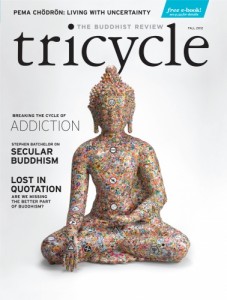Leap of Faith
Thank you for publishing Linda Heuman’s brilliant piece,“What’s at Stake as the Dharma Goes Modern?” (Fall 2012). Heuman’s articulate exposition of the fundamental misapprehension that underpins so much of the discussion regarding Buddhism in the West not only helps to clarify that discussion, but also provides an incontrovertible argument for inclusion and for open-minded investigation.
Heuman relies on Buddhism’s basic tenets to remind us that we are presuming to stand on solid ground, that our sense of reality is constructed out of the same projections the teachings warn against, and that the presumption of certainty underlying the secular position depends on a fundamental assumption that is itself “a leap of faith.” As Heuman points out, scientific materialism is just another point of view, the “ecosystem” within which we live and breathe. It is our challenge to see this and to think, act, and practice beyond its limitations.
—Patricia Anderson
Stone Ridge, NY
Something Beyond
“Religious sensibility comes in two types. One type of sensibility [philosopher Charles Taylor calls it ‘closed’] understands the highest good and deepest sources of meaning to be located within this world; the other sensibility—an ‘open one’— seeks connection to the sacred in something beyond.”
—Linda Heuman, “What’s at Stake as the Dharma Goes Modern?”
Linda Heuman’s otherwise significant and important essay willfully imposes Charles Taylor’s categories of open and closed sensibilities to what’s happening in contemporary debates on the nature of Buddhist teachings in the West.
In the Zen Buddhist tradition, when Layman Pang speaks of his most “miraculous” activity, he speaks of chopping wood and carrying water. This is Buddhist “secularism” at its grandest; its notion of “miraculous” does not exclude the transcendent (if we must speak in categories), but it does not look to “something beyond.” Other Zen poets have spoken of the entire universe contained in a single dewdrop as it hovers on the top of a tiny leaf. This is a vision of the interconnectedness of everything in the universe, not something beyond but in the here and now. Whether this vision should be called “secular” is up for discussion, but I am happy to speak of it as a framework of “personal sanity” and use it as a definitional marker for Buddhist thought and practice.
Heuman raises a number of significant issues about the secular and the possible nature of the transcendent in her essay, and they need to be discussed seriously. This letter to the editor is not that place. I only wish to point out the comment attributed to Voltaire “If we believe absurdities, we will commit atrocities” ought to be central and unobscured in any Buddhist discussion about the “transcendent” and “something beyond” as well as the associated issue of “belief” and “faith.”
—Mu Soeng
Barre Center for Buddhist Studies
Barre, MA

Any Tree Will Do
Thanks to Stephen Batchelor for his brilliant and incisive essay on secular Buddhism (“A Secular Buddhist,” Fall 2012). Returning to the roots of Buddhism, I remember that the dharma is simply a set of insights that came to a man as he sat under a tree, let go of all his preconceptions, and opened his heart to the world. We don’t need the Buddha or Buddhism; the same insights are available to us if we just sit under a tree, let go of our preconceptions, and open our hearts. Any tree will do. Or a rock, or a bus shelter, or a billboard.
What makes these insights meaningful—and this is the hard part—is living by them.
—Todd Rose
Ithaca, NY
This Is It
I enjoyed the fact that Stephen Batchelor’s “A Secular Buddhist” appeared in the same issue as “What’s at Stake as the Dharma Goes Modern” by Linda Heuman. It is just this sort of broad coverage of the Buddhist community that makesTricycle such a valued resource.
Personally, I don’t believe the historical Buddha ever intended his thoughts and teachings to become an “ism.” Centuries of well-meant translations and “clarifications” have transformed a “do” system into a “belief” system.
I think Siddhartha’s message was simply: “This is something that worked for me; if you are suffering you may want to see if it works for you.” The message is about living life, this life, with awareness and purpose. Karma must be dealt with now, with each step we take, not in some future life. One of my favorite New Yorker cartoons showed an old Buddhist teacher answering his student’s impatient question this way: “Nothing happens next. This is it.”
—Mike Mahoney
Sandpoint, ID
It’s Relative
I suppose that as a result of Rita M. Gross’s brave attempt to tread the narrow path between the literalism of blind faith and Western empiricism (“The Truth about Truth,” Summer 2012), I must conclude that the truth about truth is that truth is relative. The discernment of any truth displayed by historical fact or religious parable depends upon the minds observing that truth. No fact and no story are understood in precisely the same way by different minds, or even by the same mind at different times. As Buddha teaches, facts and myths, like all phenomena, are interdependent. So we can’t be sure of anything, no matter how logical or how holy. Is this uncertainty the middle way Rita Gross offers us?
—Ace Remas
Larkspur, CA
Thank you for subscribing to Tricycle! As a nonprofit, we depend on readers like you to keep Buddhist teachings and practices widely available.